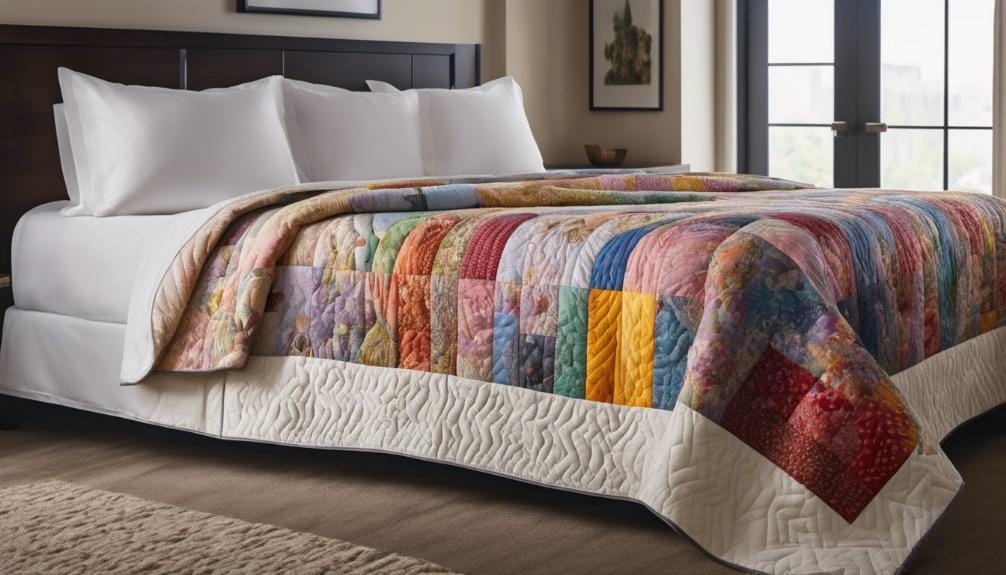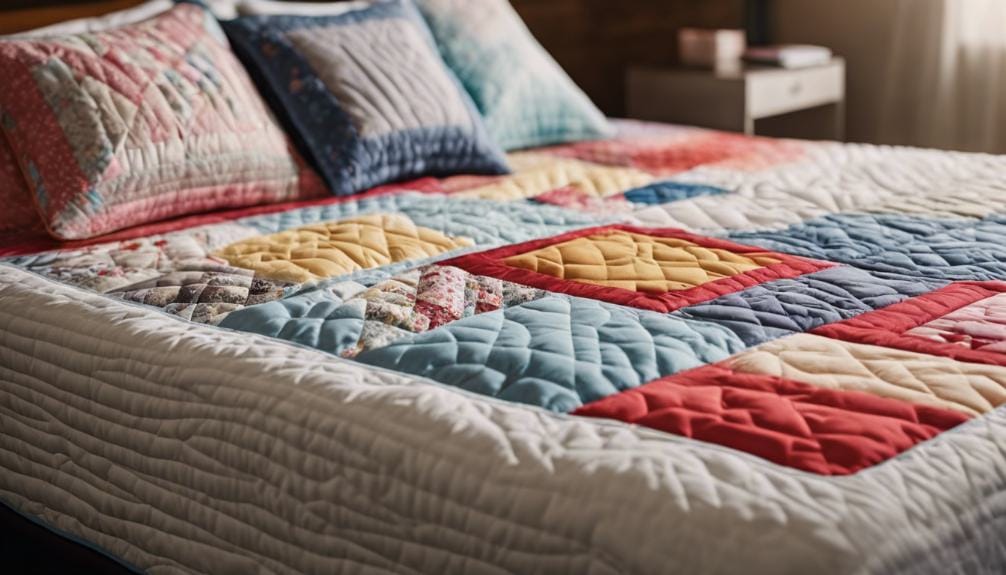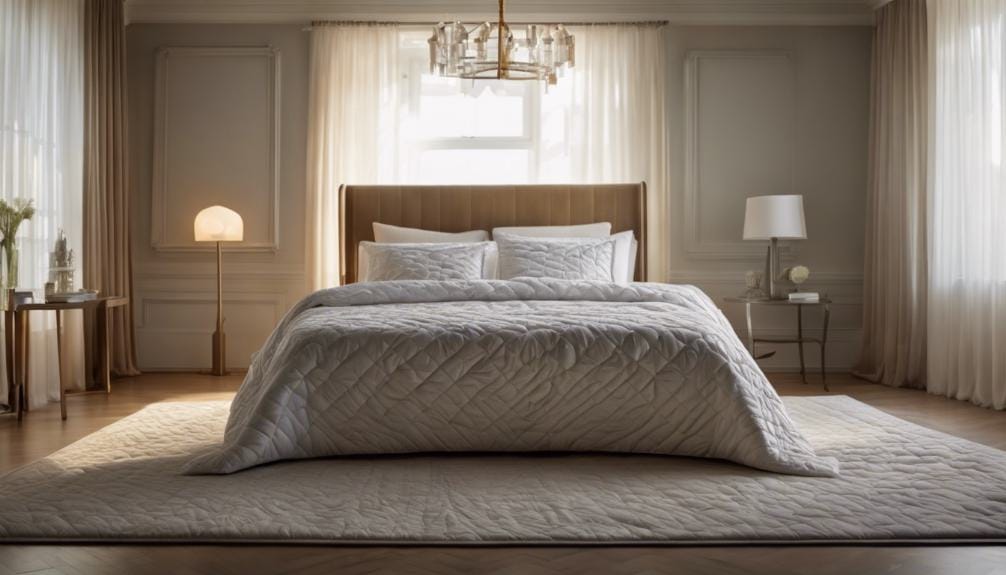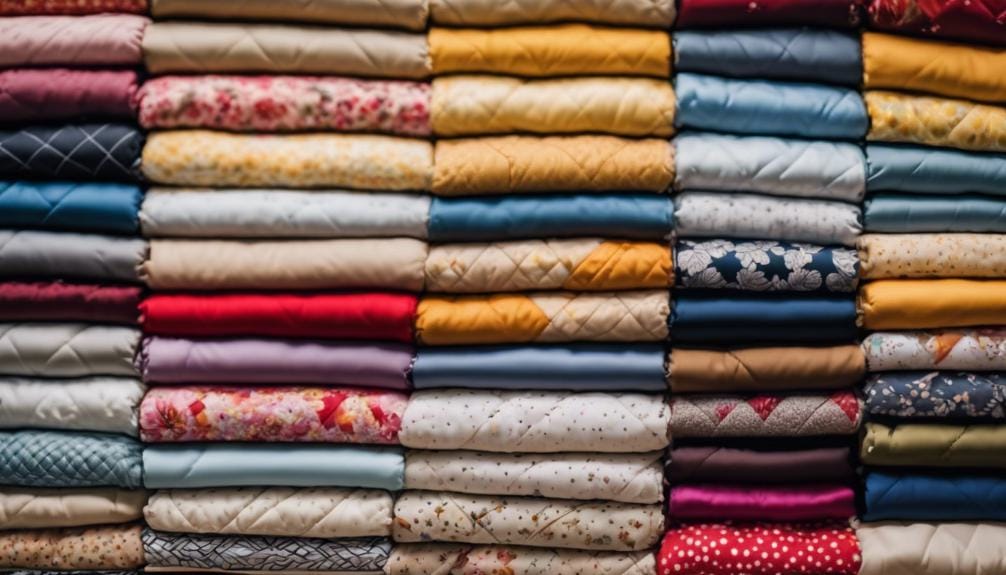How Big Should a Quilt Be: Expert Tips and Guidelines
When it comes to deciding how big a quilt should be, the size can significantly impact its overall functionality and aesthetic appeal. Factors such as bed size and personal preferences play a crucial role in determining the ideal dimensions.
Whether you are aiming for a cozy quilt for a single bed or a statement piece for a king-size bed, finding the perfect size is key. Stay tuned to discover expert insights on selecting the right dimensions to ensure your quilt fits seamlessly into your space and style.
Key Takeaways
- Consider bed size and personal preferences when determining quilt dimensions.
- Choose standard quilt sizes or customize based on quilt patterns and intended use.
- Ensure quilt fits by using exact bed measurements and allowing for overhang.
- Common quilt sizes range from baby quilts to king quilts, meeting different needs and preferences.
Factors to Consider for Quilt Size
When determining the size of a quilt, several factors must be carefully considered to ensure it meets both functional and aesthetic requirements. The size of the quilt is crucial as it should match the dimensions of the bed to provide adequate coverage and functionality. Standard quilt sizes, such as twin, full, queen, or king, can serve as a helpful starting point when deciding on the dimensions of your bed quilt.
Quilt patterns also play a significant role in determining the finished size of your quilt. Some patterns may result in a smaller or larger quilt, so it’s essential to take this into account when planning your project. For example, a queen size bed quilt will have specific measurements that differ from a twin or king size quilt. Consulting a quilt size chart can aid in selecting the appropriate dimensions based on the bed size and the desired overhang.
Considering the intended use of the quilt is also crucial. If you’re looking for a quilt that offers more warmth or comfort, you may prefer a larger size. Personal preferences such as the amount of overhang you desire or the weight of the quilt can also influence the ideal dimensions. By customizing the quilt size to fit your specific needs and preferences, you can ensure that the finished product meets all your requirements.
Bed Size Guidelines for Quilts

To ensure your quilt fits the bed perfectly and provides both functionality and aesthetic appeal, it is essential to consider the recommended dimensions for different bed sizes. When creating bed quilts, it’s crucial to match the size of the finished quilt to the specific bed dimensions. Here are the standard sizes for bed quilts based on common bed sizes:
| Bed Size | Recommended Quilt Size |
|---|---|
| Twin | 68 x 88 inches |
| Twin X-Long | 68 x 93 inches |
| Full/Double | 84 x 88 inches |
| Queen | 90 x 95 inches |
| King | 106 x 95 inches |
| Cal-King | 102 x 99 inches |
For a twin bed, a quilt measuring 68 x 88 inches is ideal, while a twin X-Long bed would require a slightly longer quilt at 68 x 93 inches. Full/double beds are best suited with quilts of 84 x 88 inches, and queen beds should be adorned with quilts measuring 90 x 95 inches. King size beds typically need larger quilts at 106 x 95 inches, and Cal-King beds would require a quilt size of 102 x 99 inches. These standard dimensions ensure that your bed quilt not only fits the bed correctly but also enhances the overall look of your bedroom.
Design Considerations for Quilt Size

Considering various design factors can significantly impact the optimal size of a quilt tailored to your specific creative vision and intended purpose. When deciding on the size of your quilt, it’s essential to consider the different sizes of quilts available and match them to their intended use. For example, crib quilts are smaller and ideal for cribs, while throw quilts are larger and perfect for snuggling on the couch. Table runners come in a variety of sizes, depending on the table they’ll adorn.
If you’re looking to make a quilt for a bed, it’s crucial to know the standard mattress sizes to ensure a proper fit. For a modern touch, you might consider creating a Wedding Ring quilt, which typically requires precise measurements due to its intricate design. Your personal creativity and aesthetic preferences should guide you in choosing the size that best suits your vision.
To make quilts that fit perfectly, it’s important to ensure they match the dimensions of the intended surface, whether it’s a bed, wall, or table. Utilizing suggested quilt sizes and accessing printable guides can offer valuable assistance in determining the ideal dimensions for your project. By carefully considering these design factors, you can create a quilt that not only fits impeccably but also enhances the overall aesthetic appeal of your space.
Tips for Ensuring Quilt Fits

For the quilt to fit perfectly, it’s essential to carefully consider the dimensions of the intended surface, ensuring a seamless and aesthetically pleasing outcome. To make sure your quilt fits just right, follow these expert tips:
- Use Exact Bed Measurements: Take accurate measurements of your bed, including the mattress thickness, to determine the ideal quilt size. Consider any additional length needed for tucks or to accommodate different mattress sizes.
- Consider Overhang Allowance: To achieve the desired look, factor in the overhang allowance. This ensures that the quilt adequately covers the mattress without being too short or excessively long, providing a polished appearance.
- Customize for Personal Touch: View yourself as the quilt maker, allowing for personalization and creativity in choosing the size. Feel free to customize the quilt size to align with your style preferences and desired aesthetic. Take inspiration from available resources but remember to add those extra inches to tailor the quilt to your unique tastes.
Common Quilt Sizes for Reference

When selecting a quilt size, it is crucial to match it with the dimensions of the intended surface to ensure a perfect fit and a visually appealing outcome. Whether you are making a quilt for a baby, a throw for your sofa, or a California King-sized quilt for tall people, choosing the right size is essential. Below is a reference table with common quilt sizes to help you select the appropriate dimensions for your next project:
| Type of Quilt | Size Range (inches) |
|---|---|
| Baby Quilts | 36 x 36 to 52 x 52 |
| Lap Quilts | 52 x 52 to 52 x 78 |
| Throw Quilts | 50 x 65 to 60 x 80 |
| Twin Quilts | 64 x 86 to 72 x 96 |
| Queen Quilts | 90 x 95 |
| King Quilts | 108 x 108 |
When sewing a quilt for a baby, keep in mind that sizes typically range between 36 x 36 to 52 x 52 inches to provide cozy comfort for infants and toddlers. Lap quilts, measuring around 52 x 52 to 52 x 78 inches, are perfect for keeping legs warm while sitting or lounging. For taller individuals or those looking for extra coverage, a California King-sized quilt at 108 x 108 inches might be the ideal choice. Remember to consider the dimensions of the surface where the quilt will be placed and the preferences of the intended user to ensure the quilt is the right size for its purpose.
Frequently Asked Questions
How Large Is a Standard Quilt?
A standard quilt varies in size based on the type of bed, with dimensions for twin, full, queen, and king beds. A queen-sized quilt typically measures around 99 x 108 inches, while a king-sized quilt is usually 108 x 108 inches.
How Much Bigger Should Quilt Be Than the Bed?
To ensure proper coverage and overhang for your bed, aim for a quilt that is about 4-10 inches wider and longer. This additional size allows for tucking in and keeping the quilt securely in place during use.
What Is the Average Size of a Homemade Quilt?
When making a homemade quilt, the average size is around 84 x 92 inches for a queen bed. This size ensures ample coverage and a cozy feel. Consider the bed’s dimensions and personal preferences to craft the perfect quilt.
What Is a Good Size for a Throw Quilt?
For a cozy throw quilt, aim for dimensions around 50 x 60 inches to 60 x 72 inches. This size allows for snuggling solo or sharing comfortably. Consider the space where you’ll use it for the perfect fit.
Conclusion
In conclusion, when determining the size of a quilt, it’s crucial to consider factors such as bed size, personal preferences, and quilt pattern. By tailoring the dimensions to match the intended use and recipient’s needs, you can ensure both functionality and aesthetic appeal.
Remember to follow bed size guidelines, consider design elements, and use tips to ensure the quilt fits perfectly. With these considerations in mind, you can create a quilt that’s visually pleasing and comfortable for its intended purpose.



